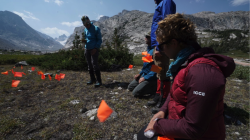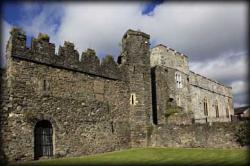INSTITUT SUPERIEUR D'ANTHROPOLOGIE
INSTITUTE OF ANTHROPOLOGY
ONLINE COURSES / COURS A DISTANCE
FALL TERM : OCTOBER 2015
REGISTER NOW
ROYAUME UNI –  Leicester - Archaeologists have unearthed evidence of Roman and medieval occupation while excavating a city centre building site. A team from the University of Leicester, led by Mathew Morris - site manager during the hunt for Richard III - has uncovered the remains of a number of medieval gardens at the former Southgates bus station, in Leicester.
Leicester - Archaeologists have unearthed evidence of Roman and medieval occupation while excavating a city centre building site. A team from the University of Leicester, led by Mathew Morris - site manager during the hunt for Richard III - has uncovered the remains of a number of medieval gardens at the former Southgates bus station, in Leicester.
http://www.leicestermercury.co.uk/Medieval-Roman-archaeology-discovered-beneath/story-27794119-detail/story.html
USA –  Dinwoody Glacier - Twenty students and faculty from Central Wyoming College made startling discoveries at the base of Gannett Peak, Wyoming’s highest mountain, and on the Dinwoody Glacier during late August. Archaeology, Environmental Science, and Outdoor Education students on the Inter-disciplinary Climate Change Expedition (ICCE) researched various hydrological and archaeological aspects of the glacier and high mountain environment including human occupations of the area during the last twelve thousand years. CWC archaeologists were thrilled to discover what preliminary evidence suggests is Wyoming’s highest-known buffalo jump on a barren, rocky mountainside at 11,000 feet above sea level. Most jumps are in the basins of Wyoming, Montana and the plains states at much lower elevations, typically between 3,000 and 8,000 feet. Prehistoric mountain sheep traps are known in the high mountains, but this discovery adds a new component to the growing field of high-elevation archaeology. Additional discoveries included several campsites that may have been used by Paleoindian mammoth hunters and their descendants. Additional fieldwork is planned to further all these natural and cultural studies in 2016.
Dinwoody Glacier - Twenty students and faculty from Central Wyoming College made startling discoveries at the base of Gannett Peak, Wyoming’s highest mountain, and on the Dinwoody Glacier during late August. Archaeology, Environmental Science, and Outdoor Education students on the Inter-disciplinary Climate Change Expedition (ICCE) researched various hydrological and archaeological aspects of the glacier and high mountain environment including human occupations of the area during the last twelve thousand years. CWC archaeologists were thrilled to discover what preliminary evidence suggests is Wyoming’s highest-known buffalo jump on a barren, rocky mountainside at 11,000 feet above sea level. Most jumps are in the basins of Wyoming, Montana and the plains states at much lower elevations, typically between 3,000 and 8,000 feet. Prehistoric mountain sheep traps are known in the high mountains, but this discovery adds a new component to the growing field of high-elevation archaeology. Additional discoveries included several campsites that may have been used by Paleoindian mammoth hunters and their descendants. Additional fieldwork is planned to further all these natural and cultural studies in 2016.
http://county10.com/2015/09/11/cwc-students-make-fascinating-discoveries-on-dinwoody-glacier/
IRLANDE –  Swords Castle - A month-long community archaeology project comes to an end this Friday at Swords Castle and has uncovered more information about the castle than the team behind the project could ever have hoped for including an entire new building buried beneath the ground that dates back more than 600 years. There was huge excitement at the Swords Castle - Digging History project last week as the team of volunteers under the stewardship of community archaeologist with Fingal County Council, Christine Baker, uncovered a medieval floor tile in its original position that has been dated between the years of 1350 and 1550. The tile was on the floor of a new building uncovered in the dig, where geophysical date has suggesting a the walls of a building were beneath the castle grounds, were confirmed. The new building has been uncovered near the north wall of the castle complex and while archaeologists have no idea at this early stage, what the building was used for, the presence of this ornate floor tile and evidence of highly decorative window traces, suggest it was a high status building. According to community archaeologist, Christine Baker, there is also some evidence at this early stage of the investigation that the building was burnt down at some point in its history, causing the roof to collapse. The floor tile itself is thought to have been imported to the site from Chester and matches tiles found in high status buildings in Dublin like Christchurch and St Patrick's Cathedral. To find the tile would have been exciting enough but to find it 'in situ' in its original position on the floor of the building is a rare and thrilling discovery for the archaeological team.
Swords Castle - A month-long community archaeology project comes to an end this Friday at Swords Castle and has uncovered more information about the castle than the team behind the project could ever have hoped for including an entire new building buried beneath the ground that dates back more than 600 years. There was huge excitement at the Swords Castle - Digging History project last week as the team of volunteers under the stewardship of community archaeologist with Fingal County Council, Christine Baker, uncovered a medieval floor tile in its original position that has been dated between the years of 1350 and 1550. The tile was on the floor of a new building uncovered in the dig, where geophysical date has suggesting a the walls of a building were beneath the castle grounds, were confirmed. The new building has been uncovered near the north wall of the castle complex and while archaeologists have no idea at this early stage, what the building was used for, the presence of this ornate floor tile and evidence of highly decorative window traces, suggest it was a high status building. According to community archaeologist, Christine Baker, there is also some evidence at this early stage of the investigation that the building was burnt down at some point in its history, causing the roof to collapse. The floor tile itself is thought to have been imported to the site from Chester and matches tiles found in high status buildings in Dublin like Christchurch and St Patrick's Cathedral. To find the tile would have been exciting enough but to find it 'in situ' in its original position on the floor of the building is a rare and thrilling discovery for the archaeological team.
http://www.independent.ie/regionals/fingalindependent/news/new-building-uncovered-at-the-castle-31507674.html
INDE – Nidamarru - Frequent discoveries of precious artefacts of the Buddhist era in ancient Amaravati town and its surrounding areas are telltale signs of the criminal neglect of our cultural wealth. This region abounds in untapped historic wealth. A survey conducted in and around Nidamarru, a village in the CRDA, close to Mangalagiri town, yielded yet another image of Buddha of the Vajrayana phase. The ancient find is an Amitabha sculpture of Buddha in dyana mudra in Padmasana. Amitabha’ means ‘infinite light’; it is also called ‘The Buddha of Immeasurable Life and Light’. Practitioners of the Pure Land Schools of Buddhism (found in China, Hong Kong, Taiwan, and Japan) believe that reciting the holy name of Amida (Amitabha) Buddha with devotion will direct their consciousness into his “pure land after death”. The 4-ft-high and 3-ft-wide sculpture is carved out of black basalt stone. “The unique feature of this image lies in the Ushnisha , the flaming décor on the head of Buddha, symbolising the enlightenment,” says Prof. Nagireddy. Pointing to the position of the sculpture’s arms which indicate that the hands are held on the lap in a gesture of meditation, he says it suggests that this sculpture represents Amitabha, a celestial Buddha who presides over the pure land of paradise of Sukhavati in the western quadrant of the cosmos.
http://www.thehindu.com/news/cities/Vijayawada/one-more-buddha-sculpture-found-at-nidamarru/article7647950.ece?
ROYAUME UNI –  Bradgate Park - Archaeologists working at Bradgate Park have found a "potentially history-changing discovery" relating to the former home of Lady Jane Grey. The team made an exciting and unexpected discovery, which shows that Bradgate House, originally thought to have been built on a new site, was in fact built on the demolished remains of an earlier building. Dr Richard Thomas, acting head of the university's School of Archaeology and Ancient History, said: "Inside the courtyard of Bradgate House we found our most tantalising and potentially history-changing discovery – the buried building doesn't line up with the rest of the house and was demolished and back-filled in the late 15th or early 16th century. "Could this be earlier than Bradgate House itself, which was completed around 1520? "If so, it would change our understanding of the house completely, because all traditional histories state that the house was built on a new site. Archaeologists found the walls of what they believe to have been the medieval park keeper's lodge.The three-month project, which also included additional trenches in other parts of the park, also turned up evidence of more than 12,000 years of occupation including Roman coins and pottery, medieval coins, Paleolithic flints and a musket ball.The discovery of Roman pottery added to the "slight but growing evidence for a Roman presence in the park", said Dr Thomas. The excavation of a moated outbuilding produced another well-preserved structure – possibly from the 17th or 18th century – which Dr Thomas said might have served as a cart-house
Bradgate Park - Archaeologists working at Bradgate Park have found a "potentially history-changing discovery" relating to the former home of Lady Jane Grey. The team made an exciting and unexpected discovery, which shows that Bradgate House, originally thought to have been built on a new site, was in fact built on the demolished remains of an earlier building. Dr Richard Thomas, acting head of the university's School of Archaeology and Ancient History, said: "Inside the courtyard of Bradgate House we found our most tantalising and potentially history-changing discovery – the buried building doesn't line up with the rest of the house and was demolished and back-filled in the late 15th or early 16th century. "Could this be earlier than Bradgate House itself, which was completed around 1520? "If so, it would change our understanding of the house completely, because all traditional histories state that the house was built on a new site. Archaeologists found the walls of what they believe to have been the medieval park keeper's lodge.The three-month project, which also included additional trenches in other parts of the park, also turned up evidence of more than 12,000 years of occupation including Roman coins and pottery, medieval coins, Paleolithic flints and a musket ball.The discovery of Roman pottery added to the "slight but growing evidence for a Roman presence in the park", said Dr Thomas. The excavation of a moated outbuilding produced another well-preserved structure – possibly from the 17th or 18th century – which Dr Thomas said might have served as a cart-house
http://www.leicestermercury.co.uk/Exciting-archaeologists-Bradgate-Park-dig/story-27788936-detail/story.html